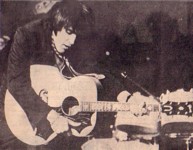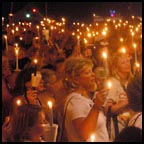 |
If
Elvis never really left the building, it seems Diana has.
Five years after her tragic death in a Paris car crash,
the princess who was once the most-photographed woman
in the world is slipping from the public consciousness,
and her status as a cultural icon is waning fast, experts
say. |
 |
"She
did a lot of work for charities and she touched a lot of people,
but socially and culturally, I think she has been forgotten,"
said Rob Turnock, author of Interpreting Diana.
On
a recent visit to England, Michael Graham, an associate professor
of history at the University of Akron in Ohio, was struck
by "how absent she was."
"There's
the Andy Warhol notion of 15 minutes of fame," said Graham,
who specializes in British history. "She definitely had more
than 15 minutes, but it seems to me that that moment has passed."
Diana
vs. Elvis When news broke in the early morning hours of Aug.
31, 1997, that Diana, Princess of Wales, was dead at the age
of 36, Britons abandoned their stiff upper lips for an orgy
of grief. Hundreds of thousands of people gathered in the
streets, and seas of flowers and teddy bears were left outside
Buckingham and Kensington palaces. Mourners lined the streets
for miles, waiting for her funeral cortege to pass.
Around
the world, viewers who couldn't be there in person were glued
to the extensive TV coverage. Fast-forward five years, and
it's quite a different story. Although the design for a memorial
fountain/water garden in London's Hyde Park was recently announced,
the fifth anniversary of Diana's death is expected to pass
without any major commemorations. Any public notice will pale
in comparison to the outpouring of nostalgia earlier this
month that greeted the 25th anniversary of Elvis Presley's
demise.
"It's
interesting how her anniversary comes at the same time as
this big anniversary of Elvis' death," said Robert Thompson,
a professor of media and popular culture at Syracuse University
in New York state.
"A
quarter of a century after Elvis' death, he is still going
strong. It's not like people have forgotten Princess Di …
but one can already see the fade begin to set in."
Elvis,
said Thompson, was a great talent, a sex symbol and a regular
guy, all in one. "He was not royalty, but he was the king
of rock 'n' roll. But he was also one of the boys - he ate
fried banana-and-peanut-butter sandwiches."
Diana,
on the other hand, "fulfilled the notion of the fairy tale
that all of us had grown up with," said Thompson. "The value
of that depends on her being alive. "If you're going to die,
you have to get resurrected by a prince's kiss."
De-emphasizing
Diana The initial outpouring of grief over Diana's death was
followed by a more critical look at her life, said Gregory
Payne, a professor of political communication at Emerson College
in Boston.
"What
we saw that first year was the debunking of Diana," said Payne,
who has studied and written about the communications aspects
of the princess' death. "She went from a saint to an individual
that did have issues.
Over
the last couple of years we've seen what I would call a leveling
off." In Diana's lifetime, "her status was very similar to
a kind of soap opera star, in a way," said Turnock, a research
fellow at the Media School at Bournemouth University in south
England.
Now
that she's no longer alive, the soap opera is over. And the
royal family, said Payne, has been very determined that the
drama revolving around Diana be buried with the princess.
Within a year of her death, "It was very clear to me that
the palace was trying to say, 'It's over,'" said Payne.
"The
palace was trying to de-emphasize Diana." If a celebrity is
going to move from mere stardom to legendary status, he or
she can't afford to lose the limelight. "Their image has to
be repeatedly disseminated over and over again for new generations,"
said Joshua Gamson, associate professor of sociology at the
University of San Francisco.
No
Diana Impersonators In the cases of icons like Elvis and Marilyn
Monroe, their images have become almost inescapable. They
have left bodies of work - records and movies - that can be
played again and again.
"With
Elvis, there are actual hard commodities - there are records,
there are films, there is memorabilia," said Turnock. "Diana
hasn't left any hard, physical artifacts," he said. "You still
see pictures of her, she's still in the news or magazines
[occasionally], but it doesn't have the same effect."
Of
course, some of the physical artifacts associated with Elvis
- from sequined jumpsuits to paint-by-numbers velvet likenesses
of the King - aren't exactly high art. But a little tackiness
apparently doesn't detract from the legend.
"Elvis
is both a serious contributor to American popular culture
and at the same time he is so memorable for his campy and
kitschy qualities," said Thompson. "But what he was most famous
for still remains" - his music.
In
fact, Elvis recently returned to the charts, thanks to a remix
of a previously somewhat obscure song called "A Little Less
Conversation." He's also heavily invoked in the Disney movie
Lilo & Stitch, which has introduced younger audiences to the
King. (Disney is the parent company of ABCNEWS.com.)
| Even
if you aren't about to make a pilgrimage to Graceland,
you're still likely to be confronted by some form of Presleymania,
said Thompson. "He has these living museums walking around
in the form of Elvis impersonators." |
 |
'The
People's Princess' In her lifetime, Diana's face graced the
cover of countless magazines, and her life has been chronicled
in both best-selling books and countless tabloid stories.
But newspapers and magazines are tossed out, and most people
don't read the same books again and again.
"Hollywood
celebrities leave a legacy in terms of movies or records,"
said Thompson. "Princess Diana has left a healthy body of
clips, but there are no definitive performances." What he
views as the princess' most important "performance" - her
1981 wedding to Prince Charles - was watched by millions of
people, but it isn't something that's regularly rerun on TV,
like an old Marilyn Monroe movie or a film starring Grace
Kelly, the American movie star who became Princess of Monaco
and died in a 1982 car crash.
In
addition to her glamorous looks, Diana was renowned for her
humanitarian causes, from promoting AIDS awareness to campaigning
against the use of land mines. But much of her charity work,
such as visiting the sick, did not have tangible results.
"A
lot of their contact with her wasn't actually made public,"
said Deborah Lynn Steinberg, a reader in the sociology department
at the University of Warwick in England. "She herself was
very genuine about what she was doing, but it was the living
her [Diana] rather than the performances" that made her famous.
In some sense, Steinberg said, Diana never became a legend
because her story simply stopped.
"What
happened after the fairy princess story went all wrong? The
story didn't continue."
Nevertheless,
Steinberg believes Diana is "still a reference point." Much
of her platform - the humanitarian causes she supported and
her attempts to open up the stuffy establishment - have been
adopted by others, Steinberg said.
"Those
kind of values she seemed to embody and be attributed with,
a lot of that has actually been taken up by the current government,"
said Steinberg. "A lot of things that crystallized around
her, [British Prime Minister] Tony Blair took that up."
Although
the government may or may not actually carry out Diana's work,
Steinberg said, it has realized the value of espousing her
values. "They aligned themselves in an astute way with 'the
People's Princess' - it become a touch phrase."
A
Living Legacy: And while the royal family wasn't wild about
Diana, she undeniably left her mark upon them. "Diana even
in death has affected the royal family. They have become much
more mainstream," said Emerson's Payne.
"They
became much more aware of PR." Diana has another legacy -
her two sons, Prince William and Prince Harry. "It seems that
the public views her children as being much more accessible
figures, more likable figures than Charles," said Graham,
the University of Akron professor.
"They're
young, they're fresh faces. They seem to reflect what people
saw in her." William, in particular, as second in line to
the throne and because of his physical resemblance to the
princess, might find himself cast in the same sort of role.
"Diana
was this well-meaning princess, a woman who got herself caught
up in politics and it ultimately killed her. She's got this
martyred status," said Thompson. "William is her issue. If
ever anybody is lined up to become part of world myth, he
seems to be the guy."
|



